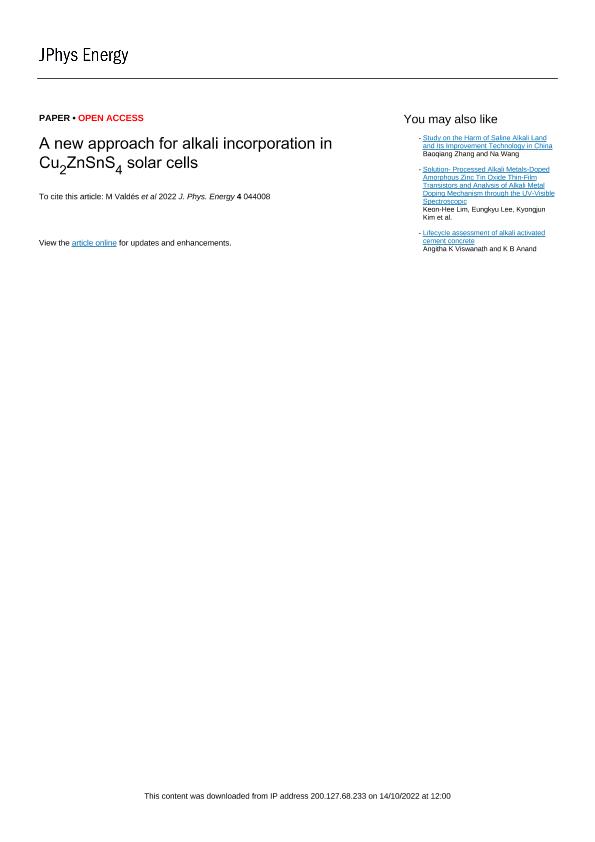Mostrar el registro sencillo del ítem
dc.contributor.author
Valdes, Matias Hernan

dc.contributor.author
Hernandez, A.
dc.contributor.author
Sánchez, Y.
dc.contributor.author
Fonoll, R.
dc.contributor.author
Placidi, M.
dc.contributor.author
Izquierdo, V.
dc.contributor.author
Cabas Vidani, A.
dc.contributor.author
Valentini, M.
dc.contributor.author
Mittiga, A.
dc.contributor.author
Pistor, P.
dc.contributor.author
Malerba, C.
dc.contributor.author
Saucedo, E.
dc.date.available
2023-09-20T13:41:30Z
dc.date.issued
2022-10
dc.identifier.citation
Valdes, Matias Hernan; Hernandez, A.; Sánchez, Y.; Fonoll, R.; Placidi, M.; et al.; A new approach for alkali incorporation in Cu2ZnSnS4 solar cells; IOP Publishing; Journal of Physics: Energy; 4; 4; 10-2022; 44008-44008
dc.identifier.uri
http://hdl.handle.net/11336/212256
dc.description.abstract
The addition of alkali elements has become mandatory for boosting solar cell performance in chalcogenide thin films based on kesterites (Cu2ZnSnS4, CZTS). A novel doping process is presented here, that consists in the incorporation of sodium or lithium during the deposition of the CdS buffer layer, followed by a post-deposition annealing (PDA). As the doping route leads to more efficient devices in comparison with the undoped reference sample, the influence of PDA temperature was also investigated. Compositional profiling techniques, time-of-flight secondary ion mass spectrometry (TOF-SIMS) and glow discharge optical mission spectroscopy (GDOES), revealed a dependence of the alkaline distribution in kesterites with the PDA temperature. Although the doping process is effective in that it increases the alkaline concentration compared to the undoped sample, the compositional profiles indicate that a significant proportion of Li and Na remains ‘trapped’ within the CdS layer. In the 200 °C-300 °C range the alkali profiles registered the higher concentration inside the kesterite. Despite this, an additional alkali accumulation close to the molybdenum/fluorine doped tin oxide substrate was found for all the samples, which is frequently related to alkali segregation at interfaces. The addition of both, lithium and sodium, improves the photovoltaic response compared to the undoped reference device. This is mainly explained by a substantial improvement in the open-circuit potential (V oc) of the cells, with best devices achieving efficiencies of 4.5% and 3% for lithium and sodium, respectively. Scanning-electron microscopy images depicted a ‘bilayer structure’ with larger grains at the top and small grains at the bottom in all samples. Moreover, the calculated bandgap energies of the CZTS films account for changes in the crystallographic order-disorder of the kesterites, more related to the PDA treatment rather than alkali incorporation. Even if further optimization of the absorber synthesis and doping process will be required, this investigation allowed the evaluation of a novel strategy for alkali incorporation in kesterite based solar cells.
dc.format
application/pdf
dc.language.iso
eng
dc.publisher
IOP Publishing

dc.rights
info:eu-repo/semantics/openAccess
dc.rights.uri
https://creativecommons.org/licenses/by-nc-sa/2.5/ar/
dc.subject
ALKALI DOPING
dc.subject
CBD
dc.subject
CZTS
dc.subject
KESTERITE
dc.subject
PDA
dc.subject
THIN FILM PHOTOVOLTAICS
dc.subject.classification
Recubrimientos y Películas

dc.subject.classification
Ingeniería de los Materiales

dc.subject.classification
INGENIERÍAS Y TECNOLOGÍAS

dc.title
A new approach for alkali incorporation in Cu2ZnSnS4 solar cells
dc.type
info:eu-repo/semantics/article
dc.type
info:ar-repo/semantics/artículo
dc.type
info:eu-repo/semantics/publishedVersion
dc.date.updated
2023-06-23T16:36:18Z
dc.identifier.eissn
2515-7655
dc.journal.volume
4
dc.journal.number
4
dc.journal.pagination
44008-44008
dc.journal.pais
Reino Unido

dc.description.fil
Fil: Valdes, Matias Hernan. Consejo Nacional de Investigaciones Científicas y Técnicas. Centro Científico Tecnológico Conicet - Mar del Plata. Instituto de Investigaciones en Ciencia y Tecnología de Materiales. Universidad Nacional de Mar del Plata. Facultad de Ingeniería. Instituto de Investigaciones en Ciencia y Tecnología de Materiales; Argentina
dc.description.fil
Fil: Hernandez, A.. Catalonia Institute For Energy Research Irec; España
dc.description.fil
Fil: Sánchez, Y.. Catalonia Institute For Energy Research Irec; España
dc.description.fil
Fil: Fonoll, R.. Catalonia Institute For Energy Research Irec; España
dc.description.fil
Fil: Placidi, M.. Universidad Politécnica de Catalunya; España. Catalonia Institute For Energy Research Irec; España
dc.description.fil
Fil: Izquierdo, V.. Catalonia Institute For Energy Research Irec; España
dc.description.fil
Fil: Cabas Vidani, A.. Swiss Federal Laboratories for Materials Science and Technology; Suiza
dc.description.fil
Fil: Valentini, M.. Enea Centro Ricerche Casaccia; Italia
dc.description.fil
Fil: Mittiga, A.. Enea Centro Ricerche Casaccia; Italia
dc.description.fil
Fil: Pistor, P.. Universidad Pablo de Olavide; España
dc.description.fil
Fil: Malerba, C.. Enea Centro Ricerche Casaccia; Italia
dc.description.fil
Fil: Saucedo, E.. Universidad Politécnica de Catalunya; España
dc.journal.title
Journal of Physics: Energy
dc.relation.alternativeid
info:eu-repo/semantics/altIdentifier/url/https://iopscience.iop.org/article/10.1088/2515-7655/ac96a4
dc.relation.alternativeid
info:eu-repo/semantics/altIdentifier/doi/https://doi.org/10.1088/2515-7655/ac96a4
Archivos asociados
